- July 27, 2023
- Posted by: Love Uganda Love Uganda
- Categories: Blog, Uncategorized
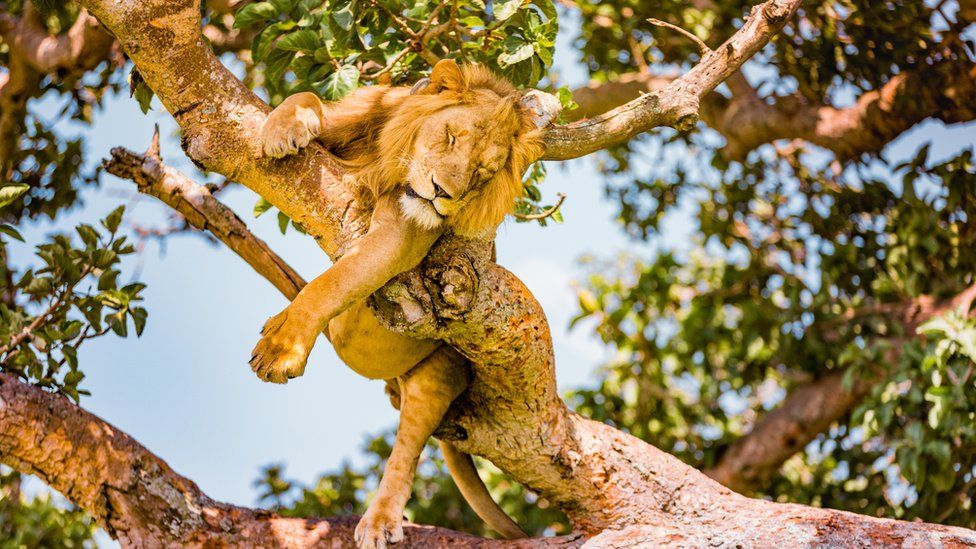
Where to see the Big Five on a Uganda safari?
The Uganda Big five Animal Safari is an exciting and adventurous experience. It allows visitors to explore the country’s diverse wildlife. The Big Five animals include elephant, lion, leopard, buffalo, and rhino. These are considered the most difficult animals to hunt on foot. Uganda is home to a number of national parks and game reserves. These parks offer excellent opportunities for wildlife viewing. Some of the most popular destinations for Uganda Big Five safaris include; Queen Elizabeth National Park, Murchison Falls National Park, and Kidepo Valley National Park. Taking on Uganda big five safaris is an opportunity for you to turn moments into memories.
In addition to the Big Five animals, visitors to Uganda’s national parks can also see a wide variety of other wildlife such as zebras, antelopes, warthogs, baboons, and different species of primates. There are also numerous bird species to be seen, making Uganda a great destination for bird
What are the Big Five animals in Uganda?
The African Lion
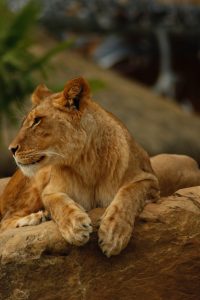
The African lion is a large carnivorous mammal that is native to Africa. It is the second-largest living cat, after the tiger. It is known for its impressive strength, agility, and majestic appearance. African lions are social animals that live in groups called pride, which can consist of up to 30 individuals. On your Uganda big five safaris to Queen Elizabeth national park, you’ll see a lion.
African lions are found in sub-Saharan Africa, primarily in savannah and grassland habitats. They are apex predators and play an important role in their ecosystems. They help to regulate the populations of other animals and maintain the balance of the food chain.
African lions are primarily carnivorous and feed on a variety of prey, including antelopes, zebras, wildebeests, and other mammals. Lions are ambush predators and use their strength and speed to take down their prey. They are known for their powerful jaws and sharp teeth, which can crush bones and tear through tough hides.
African lions are also known for their distinctive roar, which can be heard up to five miles away. Roaring is an important means of communication between lions, and is used to establish territories, attract mates, and signal other members of the pride.
Despite their status as apex predators, African lions are facing threats to their survival. Habitat loss, human-wildlife conflict, and poaching are all major threats to lion populations. According to the International Union for Conservation of Nature (IUCN), African lion populations have declined by 43% over the past two decades. The species is currently classified as “Vulnerable” on the IUCN Red List of Threatened Species. This is why you need an expert guide to be able to spot
Conservation efforts underway
Conservation efforts are underway to protect African lions and their habitats. Parks and reserves, like the Serengeti National Park (Tanzania) and Kruger National Park (South Africa), provide protected areas for lions to live and thrive. Anti-poaching and anti-trafficking measures are also being implemented to combat the illegal trade of lion parts and products.
In addition to their ecological importance, African lions are also an important cultural symbol and a major attraction for wildlife tourism in Africa. Seeing lions in the wild on a safari is a thrilling and unforgettable experience that draws visitors from all over the world. However, it is important to ensure that tourism activities are conducted in a responsible and sustainable manner, to minimize the impact on lion populations and their habitats. Book a Uganda big five lion tracking safari here.
The African Cape buffalo
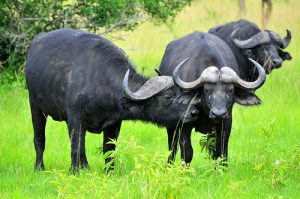
The African Cape Buffalo, also known as the African buffalo or the Cape buffalo, is a large and powerful bovine that is native to sub-Saharan Africa. It is one of the “Big Five” animals that are commonly sought after by hunters and wildlife enthusiasts on safari.
African Cape Buffaloes are known for their distinctive appearance, with their large, curved horns and thick, dark coats. They are social animals and live in herds of up to several hundred individuals. The herds are usually led by dominant males, who are known as bulls, and females and their offspring. The Uganda big five safaris to any of the savannah parks will introduce you to these giants species.
African Cape Buffaloes are herbivores and feed on a variety of vegetation, including grasses, shrubs, and trees. They are known for their ability to survive in harsh environments and can go without water for long periods of time by obtaining moisture from the plants they eat.
Behaviors
Despite their herbivorous diet, African Cape Buffaloes are known for their aggressive and unpredictable behavior. They have a reputation for being one of the most dangerous animals in Africa. They are responsible for killing more hunters than any other animal on the continent. African Cape Buffaloes have been known to charge at humans and vehicles and can inflict serious injury with their sharp horns.
African Cape Buffaloes play an important role in their ecosystems, providing food for predators such as lions and hyenas. They are also important culturally, with some African societies using their hides and horns for clothing, jewelry, and traditional ceremonies. For instance among the Baganda, there is a Buffalo clan locally known as “Abe Mbogo.” The Uganda cultural and big five safaris will take you through Buganda kingdom. You will learn a lot from them.
However, African Cape Buffaloes are facing threats to their survival. Habitat loss, disease, and hunting are all major threats to buffalo populations. Despite being a popular game animal, African Cape Buffaloes are also being targeted by illegal poaching and trade for their hides, meat, and horns.
Conservation efforts are underway to protect African Cape Buffaloes and their habitats. National parks and reserves, provide protected areas for buffalo herds to live and thrive. Anti-poaching and anti-trafficking measures are also being implemented to combat the illegal trade of buffalo parts and products.
In addition to their ecological importance, African Cape Buffaloes are also a major attraction for wildlife tourism in Africa. Seeing a buffalo herd on a safari is a thrilling and unforgettable experience for many visitors.
Rhinoceros
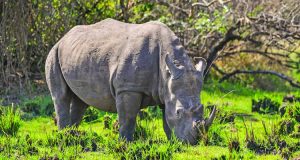
Rhinoceros, or rhinos for short, are large and powerful herbivorous mammals that are native to Africa and Asia. They are known for their prehistoric-looking appearance, with their thick, armored skin and distinctive horns. Rhinos are an important part of many ecosystems, playing a role in maintaining the balance of plant and animal populations. The Uganda big five safaris to Murchison falls national park take you via Ziwa Rhino Sanctuary for great sightings.
There are five species of rhinoceros: the black rhino and white rhino in Africa, and the Indian rhino, Javan rhino, and Sumatran rhino in Asia. All five species are listed as threatened or endangered due to habitat loss, poaching, and other threats.
Rhinos are herbivores and feed on a variety of vegetation, including grasses, leaves, and branches. They are solitary animals, except during mating season, and are known for their aggressive and territorial behavior. Rhinos have poor eyesight but a keen sense of smell and hearing, which they use to detect predators and other threats.
Rhinos are also known for their distinctive horns, which are made of keratin, the same material as human hair and nails. Rhino horns have been used in traditional medicine and as a status symbol, leading to a demand for rhino horns that has driven illegal poaching and trade. As a result, rhino populations have declined significantly in recent years, and all five species are now considered threatened or endangered.
Overall, rhinos are an iconic and important species that play a vital role in maintaining the balance of ecosystems. Protecting and conserving rhinos is essential to ensuring the long-term health and sustainability of our planet’s natural resources.
The Elephant
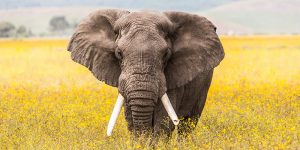
The elephant is the largest land mammal on Earth and is known for its impressive size, strength, and intelligence. Elephants are an important part of many ecosystems and play a vital role in maintaining the balance of plant and animal populations.
There are two species of elephants: the African elephant and the Asian elephant. African elephants are found in sub-Saharan Africa, while Asian elephants are found in Southeast Asia and parts of South Asia. Both species of elephants are threatened or endangered due to habitat loss, poaching, and other threats.
Elephants are herbivores and feed on a variety of vegetation, including grasses, leaves, bark, and fruit. They are social animals and live in herds, which are led by a matriarchal female. Elephants are known for their strong familial bonds and complex communication, which includes a variety of vocalizations, gestures, and tactile signals.
Elephants are also known for their distinctive ivory tusks, which are made of dentin, the same material as human teeth. Ivory tusks have been used in art and as a status symbol, leading to a demand for elephant ivory that has driven illegal poaching and trade. As a result, elephant populations have declined significantly in recent years, and both species of elephants are now
Overall, elephants are an iconic and important species that play a vital role in maintaining the balance of ecosystems. Protecting and conserving elephants is essential to ensuring the long-term health and sustainability of our planet’s natural resources.
The Leopard
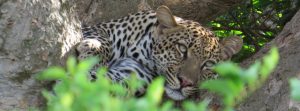
The leopard is a large and powerful feline that is native to sub-Saharan Africa and parts of Asia. It is one of the “Big Five” animals that are commonly sought after by hunters and wildlife enthusiasts on safari.
Leopards are known for their distinctive spots, which help them blend into their surroundings and avoid detection by predators and prey. They are solitary animals and are primarily nocturnal, although they can sometimes be seen hunting during the day.
Leopards are carnivores and feed on a variety of prey, including antelopes, gazelles, and other mammals. They are stealthy hunters and use their strength, speed, and agility to take down their prey. Leopards are also known for their ability to climb trees, which they use to store their kills and avoid competition from other predators.
Their extinction
Despite their strength and agility, leopards are facing threats to their survival. Habitat loss, human-wildlife conflict, and poaching are all major threats to leopard populations. According to the International Union for Conservation of Nature (IUCN), leopard populations have declined by 30% over the past three decades, and the species is currently classified as “Vulnerable” on the IUCN Red List of Threatened Species.
Conservation efforts are underway to protect leopards and their habitats. When you take on Uganda Big five safaris, ensure to give back towards the efforts.
In addition to their ecological importance, leopards are also a major attraction for wildlife tourism in Africa and Asia. Seeing a leopard in the wild on safari is a thrilling and unforgettable experience for many visitors. However, it’s important to ensure that tourism activities are conducted in a responsible and sustainable manner, to minimize the impact on leopard populations and their habitats.
Overall, leopards are an important and fascinating species that play a vital role in maintaining the balance of ecosystems. Protecting and conserving leopards is essential to ensuring the long-term health and sustainability of our planet’s natural resources.
Where to do the Uganda Big Five trip Safaris?
The Big Five tour in Queen Elizabeth national park
The Big Five tour in Queen Elizabeth National Park is an exciting wildlife experience that allows visitors to explore one of Uganda’s most popular national parks. The park is located in southwestern Uganda and covers an area of 1,978 square kilometers, making it the second-largest national park in the country.
The Big Five animals are the most sought-after animals to see on a safari in Africa, and Queen Elizabeth National Park is home to all of them. Visitors can expect to see elephants, lions, leopards, and buffalos (in the southern sector of the park) during their safari tour.
Other activities
The park offers a variety of safari experiences, including game drives, boat cruises, and walking safaris. Game drives are the most popular and allow visitors to explore the park’s diverse landscapes, from open savannahs to dense forests. Visitors can enjoy morning and afternoon game drives, which are led by experienced guides who are knowledgeable about the park’s wildlife and ecosystems.
The boat cruise on the Kazinga Channel is a highlight of a visit to Queen Elizabeth National Park. The channel connects Lake Edward and Lake George and is home to a variety of aquatic wildlife, including hippos, crocodiles, and numerous bird species. Visitors can enjoy a relaxing boat ride while spotting wildlife along the banks of the channel.
Walking safaris are another option for visitors who want a more immersive and adventurous experience. Walking safaris are led by experienced rangers who will guide visitors through the park’s wilderness areas, providing insights into the local flora and fauna, and offering an opportunity to get up close with some of the smaller wildlife such as birds, insects, and primates.
In addition to the Big Five animals, visitors to Queen Elizabeth National Park can also see a wide variety of other wildlife. The park is home to 95 mammal species and over 600 bird species, making it one of the best birding destinations in Africa. Visitors can expect to see animals such as warthogs, Uganda kobs, waterbucks, hyenas, and baboons, among others.
The best time to visit Queen Elizabeth National Park for Uganda big five safaris is during the dry season. The season runs from June to September and December to February. During this time, wildlife is more concentrated around water sources and easier to spot.
What are the accommodation options in the park?
Accommodation options in Queen Elizabeth National Park range from budget camping to luxury lodges. Visitors can choose to stay in lodges and campsites inside the park or outside the park, with options available in nearby towns like Kasese and Fort Portal. Here are some of the accommodation options available in the park:
Mweya Safari Lodge: This is a luxurious lodge located on a peninsula within the park, offering stunning views of the Kazinga Channel and the surrounding landscapes. The lodge features spacious rooms, a swimming pool, a restaurant, and a bar.
Kyambura Game Lodge: This is a luxury lodge located on the edge of the Kyambura Gorge, offering panoramic views of the savannah and the Rift Valley. The lodge features comfortable rooms, a swimming pool, a spa, and a restaurant.
Ishasha Wilderness Camp: This is a luxury tented camp located in the remote southern sector of the park, offering an authentic safari experience. The camp features comfortable tents, a restaurant, and a bar.
Enganzi Game Lodge: This is a mid-range lodge located outside the park, offering comfortable rooms, a swimming pool, a restaurant, and a bar. The lodge is located on a hilltop, offering panoramic views of the park and the surrounding landscapes.
Bush Lodge: This is a budget-friendly lodge located inside the park, offering comfortable rooms, a restaurant, and a bar. The lodge is located in a forested area, offering a peaceful and secluded atmosphere.
Camping: There are several campsites located inside the park, offering basic facilities such as toilets, showers, and fire pits. Visitors can bring their own camping gear or rent from the park. This is a budget-friendly option for visitors who want to experience the park’s wilderness and wildlife up close.
Note:
Accommodation availability and prices vary depending on the season and the level of luxury. It is recommended to book in advance, especially during the high season (June to September and December to February).
The Uganda Big Five tour safaris in Queen Elizabeth National Park is an unforgettable experience. They offers visitors the chance to see some of Africa’s most iconic wildlife. The park offers a variety of safari experiences. Accommodation options available enable visitors tailor their trip to suit their interests and budget.
The Uganda Big five safaris to Murchison falls national park
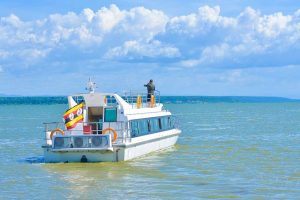
The Big Five safari to Murchison Falls National Park in Uganda is an exciting and adventurous experience that allows visitors to explore one of the most popular national parks in the country. Located in the northwestern part of Uganda, the park covers an area of 3,840 square kilometers and is home to a diverse range of wildlife.
The Big Five animals, including elephants, lions, leopards, buffalos, and rhinos (in the Ziwa Rhino Sanctuary), can all be spotted in Murchison Falls National Park. Visitors can enjoy game drives, boat safaris, and walking safaris to see these majestic animals and more.
Game drives are the most popular safari activity in Murchison Falls National Park. Visitors can expect to see a variety of wildlife, including elephants, lions, leopards, buffalos, giraffes, antelopes, and different species of primates. Game drives are conducted in the early morning and late afternoon when the animals are most active.
Boat safaris on the Nile River are a unique and exciting way to see wildlife in Murchison Falls National Park. Visitors can see hippos, crocodiles, elephants, and buffalos, as well as a variety of bird species, such as the rare shoebill stork. The boat safari also offers a chance to see the famous Murchison Falls, where the Nile River squeezes through a narrow gorge and drops 43 meters, creating a spectacular waterfall.
Walking safaris are another option for visitors who want a more immersive and adventurous experience. Walking safaris are led by experienced rangers who will guide visitors through the park’s wilderness areas, providing insights into the local flora and fauna, and offering an opportunity to get up close with some of the smaller wildlife such as birds, insects, and primates.
Accommodation in Murchison Falls National Park
There are several accommodation options in Murchison Falls National Park, ranging from budget-friendly campsites to luxurious lodges. Some of the popular lodges include:
Paraa Safari Lodge: a luxury lodge located on the banks of the Nile River, offering stunning views of the river and the park. The lodge features comfortable rooms, a swimming pool, a restaurant, and a bar.
Baker’s Lodge: a luxury lodge located on the southern bank of the Nile River, offering comfortable rooms and stunning views of the river and the park. The lodge features a swimming pool, a restaurant, and a bar.
Nile Safari Lodge: a mid-range lodge located on a hill overlooking the Nile River, offering panoramic views of the park and the river. The lodge features comfortable rooms, a restaurant, and a bar.
Red Chilli Rest Camp: This is a budget-friendly campsite located inside the park, offering basic facilities such as tents, dormitories, and a restaurant.
Ziwa Rhino sanctuary
Ziwa Rhino Sanctuary is a wildlife reserve in Uganda that is dedicated to the conservation of the white rhinoceros. The sanctuary is located in the Nakasongola district, about 176 kilometers north of Kampala. It covers an area of 70 square kilometers.
History
Ziwa Rhino Sanctuary was established in 2005 as a collaborative effort between the Uganda Wildlife Authority and the Rhino Fund Uganda. The Rhino Fund is a non-governmental organization dedicated to the conservation of rhinos in Uganda. The sanctuary was created to reintroduce the white rhinoceros to Uganda, where the species had been extinct since the 1980s due to poaching and habitat loss.
The sanctuary is home to a breeding program for white rhinos, which are one of the most endangered species of rhinoceros in the world. The program aims to increase the number of white rhinos in Uganda and to establish a self-sustaining population in the wild. The sanctuary also serves as an educational and research center, providing opportunities for visitors to learn about rhino conservation and research.
Visiting the Sanctuary
Visitors to Ziwa Rhino Sanctuary participate in activities, including guided rhino trekking, bird watching, nature walks, and cultural tours. The guided rhino trekking is the most popular activity. It allows visitors to get up close with the rhinos in their natural habitat. The treks are led by experienced guides who provide information about the rhinos and their behavior, as well as the conservation efforts being undertaken at the sanctuary.
Ziwa Rhino Sanctuary has been successful in its conservation efforts, with the white rhino population steadily increasing since the sanctuary’s establishment. As of 2023, there are over 30 white rhinos in the sanctuary. This makes it the only place in Uganda where visitors can see these magnificent animals in the wild.
The sanctuary also provides economic benefits to the local communities through tourism. The revenue generated from tourism activities is used to fund the conservation efforts at the sanctuary, as well as to support community development projects in the surrounding areas.
Generally, Ziwa Rhino Sanctuary is an important conservation center in Uganda and a model for rhino conservation efforts in Africa.
Kidepo Valley national park
Kidepo Valley National Park is located in the northeastern part of Uganda, near the border with South Sudan and Kenya. The park covers an area of 1,442 square kilometers. It is one of the most remote and less-visited national parks in Uganda. However, the park is considered one of the most beautiful parks in Africa and offers a unique safari experience.
Kidepo Valley National Park is home to a wide variety of wildlife, including the Big Four animals (elephants, lions, leopards, and buffalos). Cheetahs, hyenas, zebras, giraffes, jackals, and different species of primates can also be spotted here.
The park is also home to over 475 bird species, making it one of the best birding destinations in Africa. The ostrich, Kori bustard, and the rare Karamoja apalis are some of the bird species that can be spotted in the park.
A Uganda big five safari to Kidepo Valley national park
Safari experiences in Kidepo Valley National Park include game drives, walking safaris, and cultural tours. Game drives are the most popular safari activity in the park. The activity allows visitors to explore the park’s diverse landscapes, from open savannahs to rugged mountains. Visitors can enjoy morning and afternoon game drives. They are led by experienced guides who are knowledgeable about the park’s wildlife and ecosystems.
Walking safaris are another option for visitors who want a more immersive and adventurous experience. Walking safaris are led by experienced rangers. These guide visitors through the park’s wilderness areas, providing insights into the local flora and fauna. It is an opportunity to get up close with some of the smaller wildlife such as birds, insects, and primates.
Cultural tours are also available in Kidepo Valley National Park, which offers visitors a chance to learn about the local communities and their way of life. The Karamajong people, who live around the park, are pastoralists who have maintained their traditional way of life for centuries.
Accommodation
Kidepo Valley National Park are limited compared to other parks in Uganda, but there are still some options available. They include:
Apoka Safari Lodge: a luxury lodge located on a hill overlooking the park, offering stunning views of the surrounding landscapes. The lodge features comfortable rooms, a swimming pool, a restaurant, and a bar.
Nga’moru Wilderness Camp: a mid-range tented camp located inside the park, offering comfortable tents, a restaurant, and a bar.
Kidepo Savannah Lodge: a budget-friendly lodge located outside the park, offering comfortable rooms, a restaurant, and a bar.
Step into one these lodges on your Uganda big five safaris and create a signature of memories.
However, many of these species are facing significant threats due to habitat loss, poaching, and other human activities. Conservation efforts are essential to protecting and conserving these species for future generations.
Ziwa Rhino Sanctuary is one example of a successful conservation initiative in Africa. It is dedicated to protecting and conserving white rhinoceros populations. The sanctuary serves as a model for rhino conservation efforts in Africa. It provides economic benefits to local communities through tourism. The Sanctuary makes Uganda big fives safaris complete. It is important for visitors to Africa to enjoy wildlife tourism in a responsible and sustainable manner. This helps to minimize the impact of travel on animal populations and their habitats. By supporting conservation efforts and responsible tourism practices. You contribute to the preservation of these iconic and important species for generations to come. Check out for the Uganda big five safaris deals here
3 Comments
Leave a Reply
You must be logged in to post a comment.

[…] you planning an African safari and perhaps interested in seeing the Big 5 animals? It is high time you considered visiting Rwanda’s Akagera National Park and making your Big 5 […]
[…] you a chance to explore the life of these queens and kings of the jungle up on the tree branches. Lion tracking is an activity done by a few people per pride. This is because lions are dangerous animals and […]
[…] 4-Day Big Five Wildlife Safari in Uganda: This tour includes game drives through Murchison Falls National Park to see lions, elephants, giraffes, and other wildlife, as well as a boat cruise on the Nile River to see hippos and crocodiles. […]